Alison Cook Beatty Dance, with Guest Artists
KnJ Theater at Peridance Center
New York, New York
March 12, 2022
Artists in Motion Mini:
Alison Cook Beatty Dance: Absurd Heroes; Lifeline; Seele (excerpt); One More Day
DanceKerr & Dancers: Salto de Fede (Leap of Faith)
Neville Dance Theatre: Children’s Corner
MEAGmove: yesterday feels like tomorrow
Jerry Hochman
With the pandemic now, hopefully, over, many dance companies are presenting work that was already in the planning stages, if not substantially completed, before it began. This was the case with the program that was presented last Saturday at the KnJ Theater at Peridance Center by Alison Cook Beatty Dance and Guests. Titled Artists in Motion Mini, the program is a fraction of the full multi-evening program that Alison Cook Beatty Dance intended to present until the pandemic cancelled everything. With many of the originally selected companies now unavailable, this combined “mini” program included Alison Cook Beatty Dance’s own pieces, as well as dances performed by DanceKerr & Dancers, Neville Dance Theatre, and MEAGmove. In addition to the host company, I’ve seen Neville Dance Theatre previously; the other two groups were new to me.
The program, which included four world premieres, was a mixed bag, as such programs usually are. I’ll start with the dances presented by the host company, and then discuss the remainder of the program in the order presented.
What initially impressed me about Alison Cook Beatty Dance was choreographer Cook-Beatty’s interest in telling a story. That’s rare among contemporary choreographers. Her story dances didn’t always work, but more often than not they were admirable efforts. Moreover, and apart from any narrative, Cook-Beatty’s choreography also focuses on visualizing emotions rather than just executing steps. That too, distinguishes her work from many other contemporary choreographers, and is an attribute with which she’s been quite successful.
Based on her new dances in this program, Cook-Beatty’s work appears to have evolved in favor of her strength. Instead of attempting a complete narrative, the new pieces bring her characters’ emotions front and center. But if you think these dances are less aggressively choreographed and performed than were her prior works, think again.
Absurd Heroes, one of the world premiere pieces, concerns a struggle to accomplish … something. The audience doesn’t know what that struggle is for, or if it’s anything more than a struggle to overcome some challenge. A lot of it, visually, relates to the myth of Sisyphus, especially in the dance’s initial phase, but to me the Sisyphus myth is a metaphor for something else (both within the context of the myth itself and as Cook-Beatty uses it here).
The dance’s title undoubtedly refers to the description that Albert Camus gave to the myth in his 1942 essay “Myth of Sisyphus.” As further described in an essay written by Benjamin Rivière titled “The Absurd Hero in Camus and Godard” and published among a series of essays in the Fall, 2015 by The Stanford Freedom Project under the overall rubric “What is Freedom”:“Sisyphus is the epitome of the absurd hero because he is able to recognize the absurdity of the human condition, abandon hope, find happiness in material reality, and ultimately find meaning in the struggle itself.”
A lot of Absurd Heroes can be seen as just what is described above: a struggle for the sake of the struggle since, essentially, that’s all the viewer sees. That’s the way I looked at it as I viewed the dance. But the score that Cook-Beatty uses suggests that the dance takes the myth, and the concept of coming to terms with endless suffering, several levels beyond that.
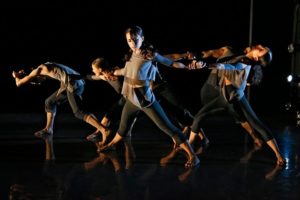
and members of Alison Cook Beatty Dance in “Absurd Heroes”
Photo by Paul B. Goode
The dance is choreographed to American “post-minimalist” composer David Lang’s “Mountain.” Lang’s composition reportedly was created in honor of Aaron Copland, and was inspired by a mountain in Vermont. I don’t know if that’s accurate, but even if it is, the composition goes far beyond that relatively mundane genesis. Reflecting this, “Mountain” was included in a Cincinnati Orchestra album (the recording used here) simply titled “Hallowed Ground,” with the rendering of a barbed-wire fence on the album’s cover.
The extraordinary musical composition begins with a series of repetitive short outbursts of sound –striking the ear like aural simulations of those merciless destructive lightning bolts unleashed by some omnipotent force that occur perpetually in human existence. More concretely, the sound is akin to the sound of missiles striking targets. Then, very slowly, melodic sounds begin to appear as if a consequence of life’s slings and arrows, growing increasingly loud and penetrating, like musical wails.
With this score as its framework, Cook-Beatty and her dancers visualize not only a persistent struggle and one that can never be overcome, but also gives these struggles a sense of meaning (as the Cincinnati Orchestra does with its album). The dance isn’t just about the perpetual challenges of everyday life (though it can be viewed that way), but those overwhelming forces that eternally seek to destroy life because the lessons of history are never learned.
In addition to references to Sisyphus (by the dancers’ simulating pushing some overwhelming weight, but repeatedly falling to the floor), Cook-Beatty visualizes the struggle by using a rope (a tug of war reference), and then by pushing and pulling among the dancers themselves. One dancer runs around the stage area as if trying to escape, but falls to the ground because escape is impossible. The struggle continues, as the dancers appear to attempt to escape from some confinement. Whatever it is, the visual message is presented with a vicious physicality. [Emblematic of this, a “Corporal Movement Coach,” Steven Colluci, is included in the piece’s credits.] These aren’t internal challenges (though, admittedly, the images can be seen as metaphors for that too), but attempts by the dancer/characters to overcome external forces that are, and will always be, more powerful than they are. There is fear in the dancers’ eyes, and panic, as if they were civilians trapped in a war zone, as well as frustration reflecting the ceaseless struggle and its unbearable futility.
I don’t think that Cook-Beatty is here condemning these “absurd heroes.” Rather, I think she’s celebrating them as true heroes, but in a perpetually losing battle.
While all the eight dancers were committed and acted their roles frighteningly well, two stood out to me (who I was able to identify based on later dances in the program): Mariah Anton, for the piercing fear and fury in her eyes and body movement, and Genaro Freire, for his expressions of utter frustration. But all (in addition to those mentioned, Jacob Blank, Madelaine Burnett, Kaysha Smith, Madeline Kuhlke, Tomislav Nevistic, and Ioanna Ioannides) merit praise … and combat pay.
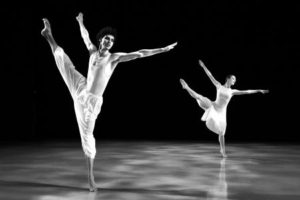
in Allison Cook-Beatty’s “Lifeline”
Photo by Paul B. Goode
Lifeline, which was performed before the first intermission, is “early” Cook-Beatty – it premiered in 2001. A duet performed by Kuhlke and Nevistic, Lifeline is a fairly typical example of a “relationship” dance, with the subject being the evolution of the relationship between the two dancers. Possibly to emphasize the purity of their emotions, each dancer is costumed in white. Choreographed to the first three variations in New Age composer Karl Jenkins’s four-part “Adiemus Variations,” the piece begins with compassionate and mutually supportive imagery (including many examples of one moving in sync – concurrently executing the same steps – with the other), continues through unspecified discord, and concludes with a resolution that indicates that the characters’ relationship has survived the trials and disagreements, whatever they were, and they look to the future together perhaps stronger now than they were before. Although that description may make the dance sound somewhat insipid, it’s not. The dancers, particularly Kuhlke, deliver nuanced performances that make the piece interesting. And although the choreography isn’t innovative or complex, it doesn’t need to be: its simplicity is a virtue. Lifeline is not a bad piece for the genre, its sincerity is genuine, and the dancers execute it well.
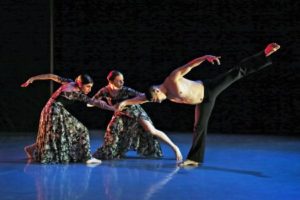
in an excerpt from Alison Cook-Beatty’s “Seele”
Photo by Paul B. Goode
An excerpt from Cook-Beatty’s Seele followed. I reviewed Seele in its entirety in my review of the 2019 Artists in Motion program, and was impressed by the mystery and dynamism in the piece. Seele is a pas de trois with two women and one man where the visualized relationship involves complex emotional currents that ultimately make it difficult to determine where the center of gravity is, or if there is one. What is clear … maybe … is that the dance reflects an emotional confrontation between two women over one man, or between a lone woman and the couple. The excerpt presented here manages to succinctly capture the sense of the piece as a whole, and the dancers, Burnett, Ioannides, and Freire, execute it very well.
The program concluded with the world premiere of Cook-Beatty’s One More Day. In its intensity and its depicted struggle, One More Day resembles Absurd Heroes, but the similarity ends there.
The dance is choreographed to a composition – “If I Had One More Day” – by Polina Nazaykinskaya and Konstantin Soukhovetski, based on a poem by Gerald Appelstein, and sung to Appelstein’s lyrics. The poem is a “grief” poem – reflecting and relating the torment one feels after the death of another: the inconsolable need for “one more day.” The dance is a dance of grief too, but the simplicity of the music combined with the anguish of the words create tension between agony and resolution that the dance replicates and translates into an emotional quagmire and a physical struggle.
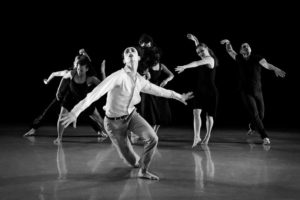
in “One More Day”
Photo by Paul B. Goode
[An aside: I attended the world premiere of a Nazaykinskaya piece, “Nostalghia,”created in collaboration with Pascal Rioult, Artistic Director of Rioult Dance NY (which, unfortunately, is a casualty of the pandemic). I observed subsequently that “Nostalghia” is an extraordinary piece of contemporary music … a quality composition that doesn’t fall prey to any current orthodoxy. Nazaykinskaya conducted the seven-member ensemble at this premiere, and one member of the ensemble, on piano, was Soukhovetski. “If I Had One More Day,” which includes vocalization of Appelstein’s lyrics, is every bit as successful.]
In Cook-Beatty’s dance, this agony is expressed as a struggle between the image of the deceased (danced by Blank) and, presumably, the deceased’s wife (Anton) – which necessarily includes the wife’s neighbors and friends: to deal with grief and eventually overcome it, it takes a village. The dance shows the deceased attempting to reach out to his wife and stay with her, seen perfectly real through his wife’s eyes, and his wife’s futile struggle to reach out to him or to join him wherever he now is. In her grief, she has to be restrained by the others. Consequently the struggle is both internal and external, and is shared by everyone in view. [In the poem / song, the lyrics are sung by a man after losing his love; here the positions are clearly reversed. This makes for some conflict – a man’s voice and a woman’s actions, but in the overall scheme of things that’s a minor issue.]
The cast delivers the choreography, and the emotions behind it, brilliantly, and with the same commitment to the choreography displayed in Absurd Heroes. Blank animates his hopeful but helpless execution very well. But Anton is the piece’s focal point. Every ounce of her body is aflame; every gaze from her eyes is wildly grief-stricken and helpless, and is clearly communicated beyond the stage to the audience. Her performance conveys a reality that stings, and that ultimately breaks the heart.
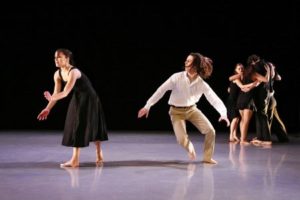
Alison Cook Beatty Dance in “One More Day”
Photo by Paul B. Goode
The evening began with the world premiere of Michael Anthony Kerr’s Salto de Fede (Leap of Faith), performed by four members of his company, DanceKerr. [The spelling of the dance’s title may really be either Salto di Fede or Salto de Fedi; I saw both spellings on the company’s web site. It also appears that the dance was performed previously, but these may have been prior incarnations of it, with this performance being the world premiere of the most recent one.] The company was founded by Kerr in 2015, following a lengthy performing career in both the U.S. and Europe. In addition to choreographing for his company, he teaches dance to public middle-school students in Brooklyn.
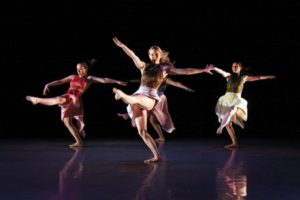
“Salto de Fede” (Leap of Faith)
Photo by Paul B. Goode
Salto de Fede is a pas de quatre, and each dancer appears on stage at the same time, most often executing the same choreography either in sync or sequentially. The music (referenced in the program as an original score by Michelle Pirret and Enigma, with arrangement by David Lawson) is soothing and contemplative. Perrit describes herself as an international Sonic Alchemist and Facilitator of Vibrational Wellness, and the creator of the Sonic Leap method, which is described as a form of sound meditation that works to promote harmonic well-being through the use of auditory stimulation. It appears that Enigma is a German band whose music reportedly includes meditative pieces. Whatever Perrit’s motivation may be, and whichever music from Enigma was used here, the sound created is perfectly appropriate for a dance that, at least by its title, requires a measure of deliberation, meditation, and spirituality. Indeed, my notes reflect that between the music and the choreography, the piece comes across as somewhat of a prayer dance – although at times I thought it might be a prayer dance by a coven. And although the movement is lyrical and at times balletic, it was performed barefoot.
Again based on the company’s web site, the four dancers apparently are supposed to represent four qualities that must be weighed while considering whether to take that leap of faith: Courage, Desire, Faith and Wisdom. But the dancers are not so identified in the program, and I saw nothing in the piece that distinguishes one dancer with one of these qualities from another, so perhaps these designations were removed as the piece’s evolution progressed. In any event, the four dancers worked hard to perform Kerr’s choreography, and Kerr’s choreography was appropriately designed for the dancers in the piece. They were: Ashley Hacker, Lindsey Jones (also the company’s rehearsal assistant), Lauren Pagano, and Olivia Villalba.
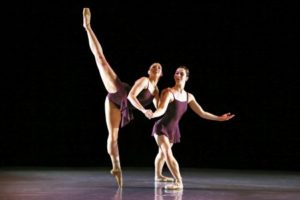
in Nanako Kitagawa’s “Children’s Corner”
Photo by Paul B. Goode
Neville Dance Theatre presented Children’s Corner, choreographed by Nanako Kitigawa. [I saw one reference to the dance being excerpts from a larger piece. I don’t know if that’s accurate, but I’ll assume it was presented in full, since there’s no indication in the program or publicity materials I saw to suggest otherwise.] The piece is a neo-classical ballet presented in a straightforward manner, which follows its score (Claude Debussy’s eponymous composition) appropriately but isn’t bound by it. It’s lyrical and tightly choreographed (no unnecessary excess) – the latter being both rare and admirable qualities.
The dance, which premiered in 2017, is as light and playful as the music to which it’s choreographed. Deconstructing it into its component parts would diminish the overall tone of the piece. Suffice it to say that the dance is very nicely structured, possesses sufficient choreographic variety to maintain interest without being overly complex, and is a fine vehicle to display the company’s dancers’ ballet proficiency. It’s also pleasant to watch. A viewer can’t ask for much more. The three company dancers were Kylie Fox, Laura Dearman, and Lauren Settembrino, and each danced commendably.
The final guest company presentation, and the program’s penultimate dance, was the fourth world premiere. yesterday feels like tomorrow was performed by dancers from MEAGmove, and choreographed by the company’s founder Meagan Ahern and the dancers. MEAGmove, which Ahern founded in 2019, describes itself as a project-based company that utilizes the talents of local freelance dancers, the goal being to foster a greater sense of community among the dancers and to make every process enjoyable, fulfilling and worthwhile. With her dance for this program, Ahern certainly creates what appears to be fun for the dancers, and it’s pleasant enough but insubstantial for an audience.
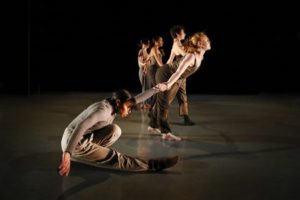
“yesterday feels like tomorrow”
Photo by Paul B. Goode
The title yesterday feels like tomorrow connotes a sense of sameness from one day to the next, but reverses the usual “today feels like yesterday” to make it sound as if it were focusing on the future – although I’m not sure it’s focusing on anything. To an eclectic score that draws from The Ink Spots, Pink Floyd, and Johannes Brahms, Ahern has crafted an equally eclectic-looking dance performed by an eclectic-looking group of seven women.
The piece opens with the dancers sitting on the stage floor. While one rises and dances solo, others watch. This yields to the group rolling and crawling on the floor (at times looking like a group exercise class), rolling atop each other, and/or seeming to roll over themselves. A common denominator is that no one seems to know what’s happening. Dancers often fall to the floor (or into the arms of others) as if the energy had been drained from them, or appear to be mired in some trance-like state from which others pull them out – or both. It all sounds disjointed, and to a large extent it is, but it looks like MEAGmove achieved its goal: to create a dance that’s fun, at least for the dancers. The dancers were Emma Andre, Katarina Belmatch, Kristina Diaz, Madison Elliott, Lara Golladay, Aurora Vaughan, and Morgan Wade.
Based on this program (and others) I look forward to Alison Cook Beatty Dance’s next Artists in Motion program.
Source: https://criticaldance.org/alison-cook-beatty-dance-and-guests-artists-in-motion-mini/

